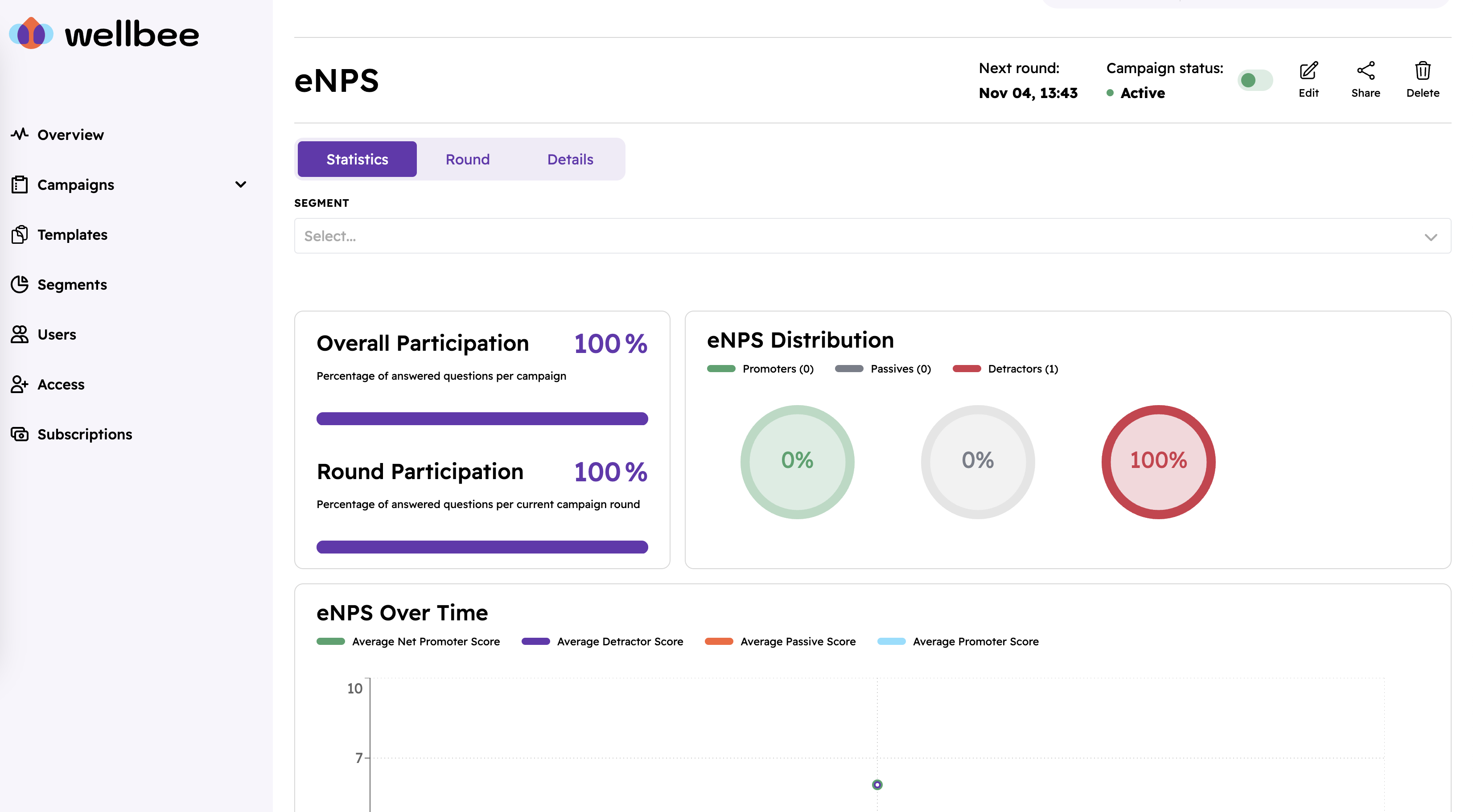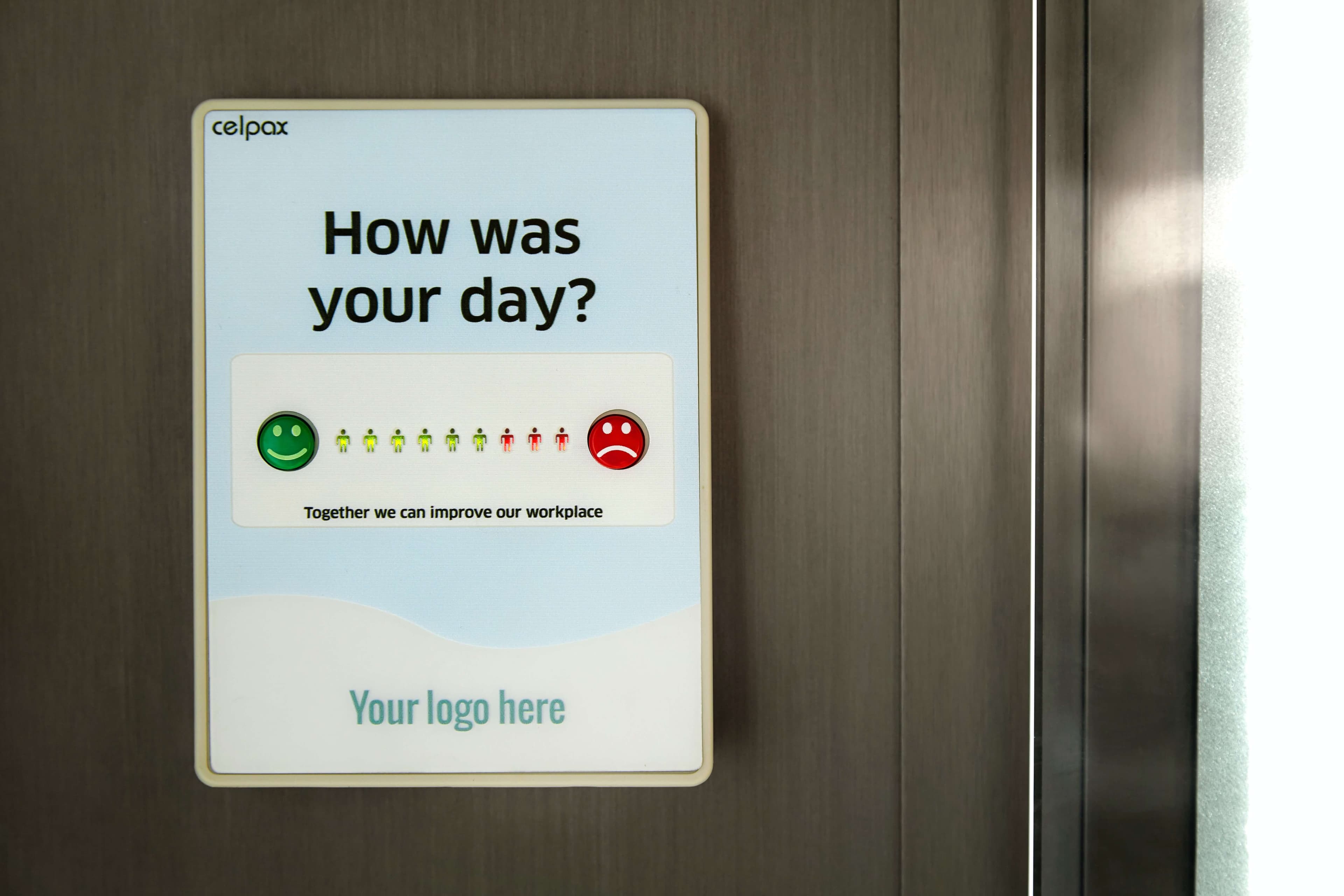Did you know that employee loyalty and satisfaction have a direct impact on your organization’s success? In an increasingly competitive marketplace, understanding and improving employee engagement is crucial. Enter the Employee Net Promoter Score (eNPS), a simple yet powerful metric that can transform the way you approach employee engagement. Are you ready to unlock the potential of your workforce? Let’s dive in!
Key Takeaways
eNPS is an effective tool to measure employee loyalty and satisfaction.
It involves sorting survey responses into three categories, using the percentages to calculate a score, and monitoring changes in sentiment.
Strategies for improving eNPS include open communication & transparency, taking action on feedback, additional tools such as pulse surveys & one-on-one meetings, and setting goals based on industry benchmarks.

Understanding eNPS: The Basics
Employee Net Promoter Score (eNPS) is a widely utilized metric. It measures employee loyalty, as well as satisfaction, which helps businesses to assess their policy effectiveness. Regular measurement of eNPS allows organizations to understand what aspects positively influence their employee experience. This significant information aids in pinpointing improvement areas and fosters a culture where satisfied employees outnumber the detractors within the organization.
However, eNPS is more than just a number. It is a powerful tool that, when used effectively, can offer organizations a competitive edge. eNPS is advantageous due to its succinctness and straightforwardness, resulting in greater effectiveness than traditional employee engagement surveys. To fully utilize its potential, it is essential to measure enps accurately and consistently.
Difference between NPS and eNPS
While Net Promoter Score (NPS) gauges customer loyalty, Employee Net Promoter Score (eNPS) concentrates on employee loyalty and satisfaction. Both ratings often exhibit correlation, as engaged employees are more likely to provide exceptional customer experiences, leading to higher customer loyalty.
In eNPS surveys, passives are employees who provide scores of 7-8, and are therefore not included in the eNPS calculation. However, their scores can still offer insights into how employees feel about the organization. Targeted follow-up questions for passives can help organizations uncover potential obstacles to enhancing employee satisfaction and loyalty.
Importance of eNPS in organizations
eNPS plays a vital role in organizations as it enables them to:
Detect and tackle employee engagement issues
Impact productivity and profitability
Be a more effective alternative to traditional employee engagement surveys
Quicker and easier to analyze
Collecting and evaluating detractors’ feedback enables organizations to:
Decrease employee turnover and associated costs
Prevent negative impact on the overall promoter score
Address the concerns of detractors for long-term success
Calculating eNPS: A Step-by-Step Guide
Calculating eNPS is a straightforward process that begins with a simple survey question: “On a scale of 0 to 10, how likely are you to recommend our company as a workplace?”. The responses to this question are then sorted into three categories: Promoters, Passives, and Detractors.
Next, the percentage of promoters and detractors is calculated, and the detractor percentage is subtracted from the promoter percentage. The resulting score provides an indication of employee engagement levels and can guide employee engagement initiatives within the organization.
Survey question and scoring system
The eNPS survey question requests employees to rate their likelihood of recommending the company as a workplace, using a 0-10 scale. This question allows for an accurate assessment of employee satisfaction and loyalty. To further enhance the survey experience, consider personalizing it by addressing employees by name and sending it through their email.
It is generally recommended to conduct eNPS surveys at least annually, though more frequent surveys may be necessary for organizations within high-intensity industries. Nevertheless, striking a balance is important; too frequent eNPS surveys could lead to survey fatigue.
eNPS formula and interpretation
The eNPS formula entails subtracting the percentage of detractors from the percentage of promoters, yielding a score that indicates employee engagement levels. A positive eNPS score implies that the organization has more promoters than detractors, suggesting relatively high employee loyalty.
Neutral employees are excluded from the eNPS formula as their score alone does not offer meaningful insights. However, obtaining feedback from these employees is still important and can provide valuable information for organizations looking to improve employee engagement and satisfaction.
Key Benefits of Using eNPS
Utilizing eNPS presents several advantages, such as simplicity, cost-effectiveness, and the capacity to promptly recognize areas for improvement in employee engagement. The succinct nature of eNPS surveys requires less effort to analyze than complex, lengthy annual surveys, thus enabling organizations to take prompt action on areas of success and areas needing improvement.
Surveys should be conducted regularly and rapidly to ensure consistent input. This allows active and well-informed feedback to be provided. Focusing on employee engagement through eNPS can contribute to overall business growth by:
Attracting new talent
Fostering innovation
Increasing revenue
Improving customer satisfaction and loyalty
Enhancing the company’s image to support growth.
Limitations and Considerations of eNPS
While eNPS is a useful tool, it does have certain limitations, such as:
Its oversimplification of employee engagement
Its inability to provide a comprehensive view on its own
Disregarding neutral or passive employees
Making benchmarking difficult
Potential biases that may be present in eNPS surveys include:
Sampling bias
Non-response bias
Acquiescence bias
Social desirability bias
Cultural bias
Impression management bias
Hence, acknowledging the limitations of eNPS and considering the use of other tools and techniques is crucial for a thorough understanding of employee engagement.
Strategies to Improve eNPS
Enhancing eNPS can be achieved by:
Consistently measuring eNPS to pinpoint areas of improvement and monitor progress over time
Maintaining open communication with employees to understand their needs and concerns
Responding to employee feedback and taking action to address any issues or concerns
Comparing eNPS scores to industry benchmarks and setting goals for improvement
Consistent measurement, open communication, and proactive response are key to improving eNPS and creating a positive work environment.
Transparency has a positive influence on eNPS, as it is associated with higher employee satisfaction, increased engagement, better retention, and a more favorable brand reputation. Additionally, transparent communication and goal-setting can help to promote teamwork, trust, and collaboration among employees, thereby contributing to improved eNPS scores.
Regular measurement and monitoring
Regularly measuring and monitoring eNPS is essential for organizations to assess progress and detect changes in employee engagement. Regular measurement of eNPS enables organizations to:
Track changes in employee sentiment
Identify trends in engagement levels
Assess the efficacy of their engagement initiatives
Make informed decisions to enhance employee satisfaction and loyalty
It is typically suggested to conduct eNPS surveys at least annually, with some organizations opting for quarterly or even monthly measurements to acquire more regular feedback and alterations in employee sentiment. The chosen frequency should align with the organization’s objectives and resources.
Open communication and transparency
Fostering open communication and transparency with employees regarding eNPS results encourages trust and involvement in the improvement process. Sharing the eNPS results may lead to actionable insights and improvements in areas that may be impacting employee satisfaction and loyalty.
Not being transparent with eNPS results could lead to:
a lack of trust among employees
decreased engagement and motivation
higher turnover rates
a negative impact on customer experiences
missed opportunities for improvement
Therefore, being honest and open with employees about eNPS results is crucial for maintaining trust and fostering a positive work environment.
Taking action on feedback
Acting upon employee feedback demonstrates dedication to resolving issues and optimizing the work environment. Organizations should inform employees of their plans to address their concerns and follow up after making improvements to ensure the desired results are achieved.
Some effective actions that can be taken in response to eNPS feedback include:
Distributing additional pulse surveys to measure the effectiveness of action plans
Analyzing comments to gain insight into employee sentiments
Hosting Q&A sessions to acquire feedback
By taking suitable action based on employee feedback, organizations can foster a culture of continuous improvement and enhance employee satisfaction.
Additional Tools for Enhancing Employee Engagement
Implementing additional resources, such as pulse surveys and one-on-one meetings, can yield a more thorough comprehension of employee engagement and satisfaction. Pulse surveys are brief and recurrent questionnaires sent to personnel to collect feedback and assess employee sentiment on particular topics. They improve employee engagement by providing a continuous feedback loop, enabling organizations to monitor progress, detect areas of enhancement, and address employee issues promptly.
Pulse surveys help create an atmosphere of open communication and demonstrate that employee opinions are valued, resulting in increased engagement and satisfaction. By combining eNPS measurement with other tools, organizations can gain a more comprehensive understanding of employee engagement and make more informed decisions to improve workplace satisfaction and loyalty.
Industry Benchmarks and Setting Goals
Benchmarking involves:
Comparing an organization’s eNPS results to those of other organizations in the same industry
Tracking an organization’s eNPS over time
Setting improvement goals based on internal trends instead of external comparisons
Focusing on internal trends allows organizations to identify areas for improvement and track progress more effectively. By setting realistic and achievable goals for eNPS improvement, organizations can foster a culture of continuous improvement and enhance employee satisfaction and loyalty.
Summary
In conclusion, the Employee Net Promoter Score (eNPS) is a powerful metric that can help organizations understand and improve employee engagement, satisfaction, and loyalty. While it has its limitations, eNPS can be effectively combined with other tools and strategies to provide a comprehensive picture of employee engagement. By regularly measuring eNPS, fostering open communication and transparency, and taking action on employee feedback, organizations can create a positive work environment that supports continuous improvement, employee satisfaction, and business success.
Frequently Asked Questions
What is a good net promoter score for employees?
A good eNPS score is generally considered to be between +10 to 30, although higher scores of up to +80 can indicate best-in-class performance.
How do you calculate net promoter score for employees?
To calculate Employee Net Promoter Score (eNPS), subtract the percentage of Detractors from the percentage of Promoters. The score is displayed as a number within the range of -100 to +100.
What is an example of employee net promoter score?
Employee net promoter score (eNPS) is calculated by subtracting the percentage of detractors from the percentage of promoters - for example, 25 promoters minus 10 detractors would result in an eNPS of +15.
Why is employee net promoter score important?
Employee Net Promoter Score is an important tool for employers to measure employee satisfaction and loyalty, as well as track employee engagement. eNPS provides deep insights on recommendations of the employee experience and helps companies measure the impact of their people and culture initiatives.
What is the difference between NPS and eNPS?
NPS measures customer loyalty, while eNPS looks at employee loyalty and satisfaction. Both scores often show a correlation, as engaged employees tend to provide better customer experiences, resulting in increased customer loyalty.
How to quickly measure eNPS with Wellbee
Sign in to Wellbee using your Slack Workspace.
Navigate to Campaigns -> Engagement.
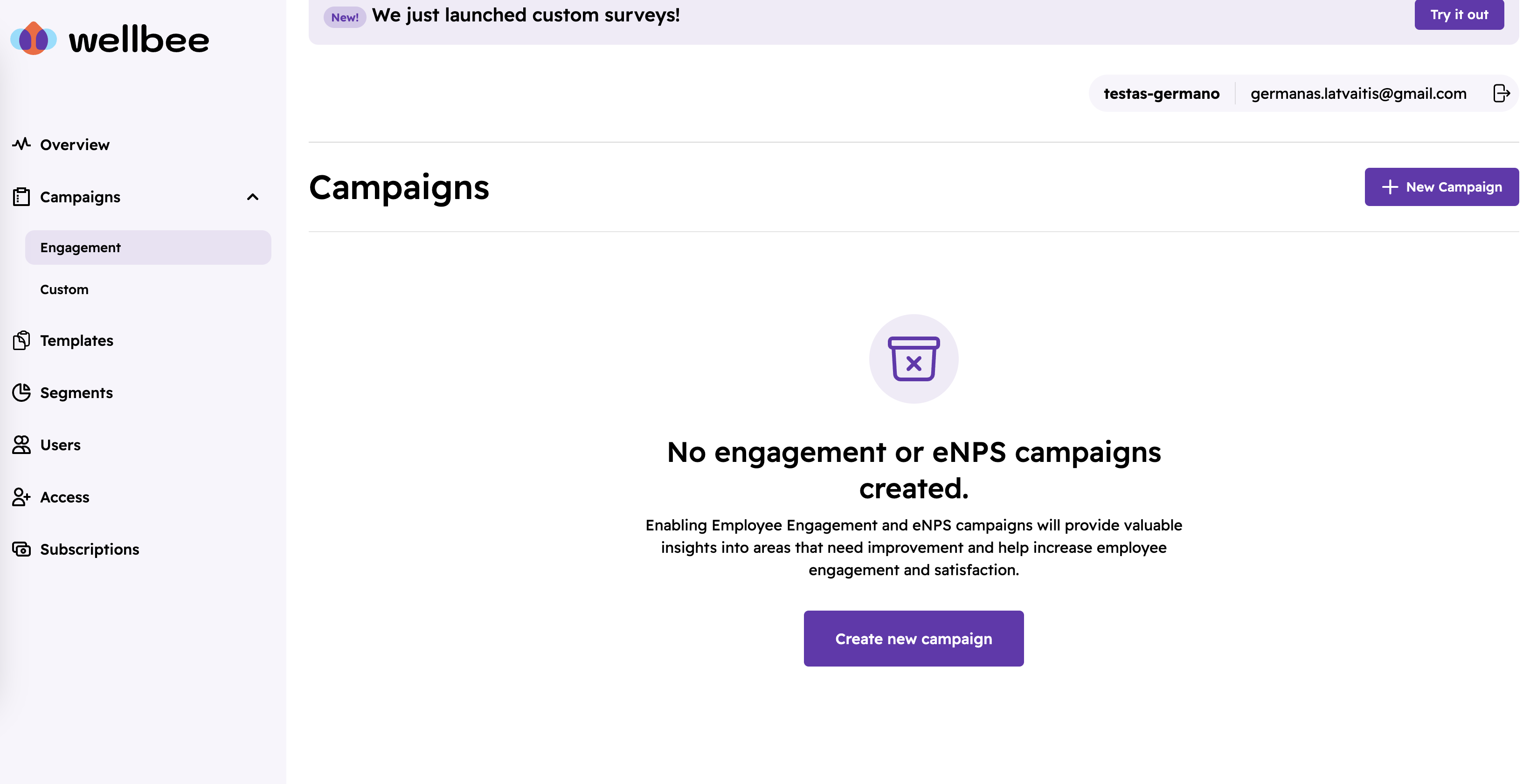
Press "New Campaign" and select eNPS as survey type.
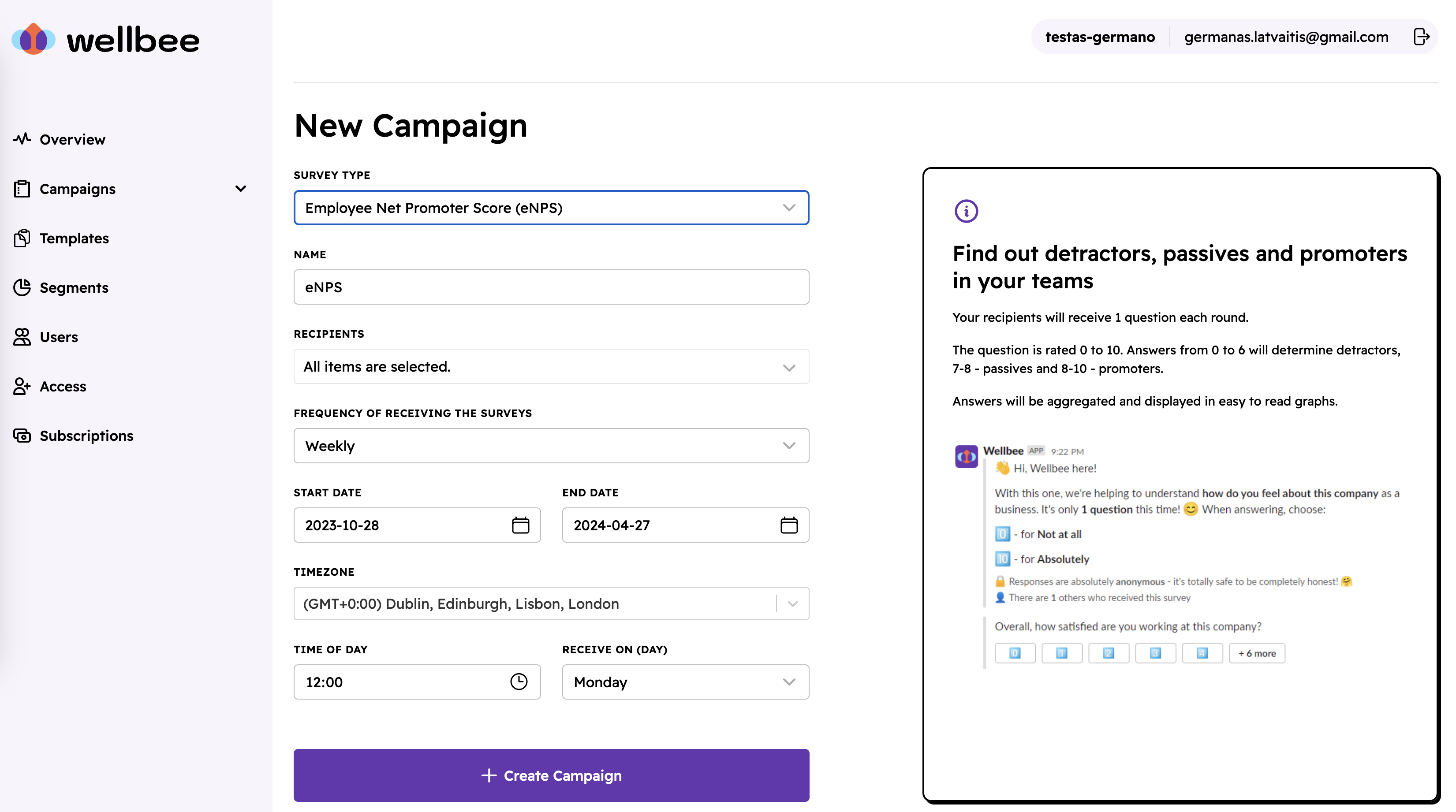
Answer the questions directly in your Slack client.
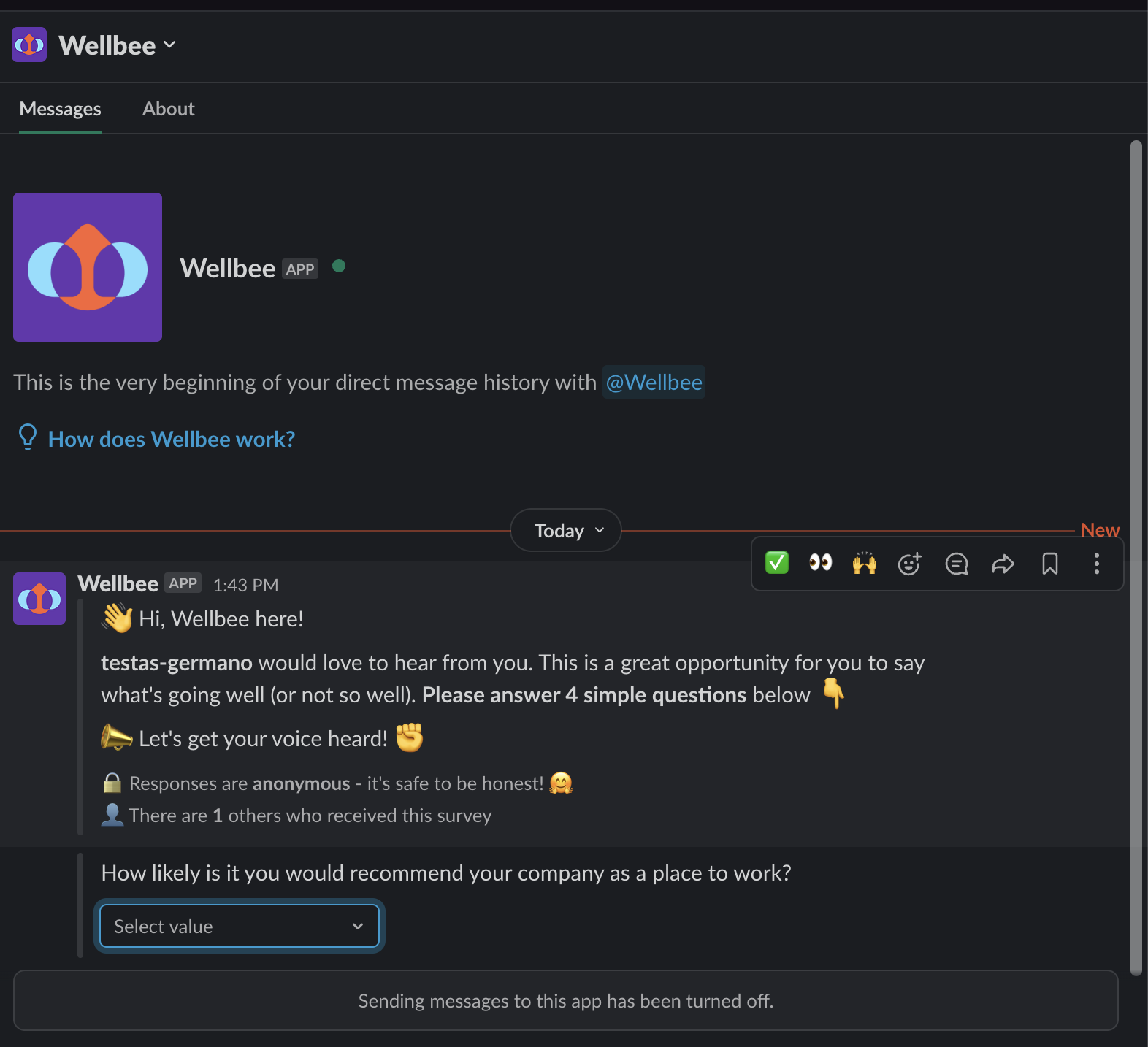
View and analyze the results.
